Input interpretation

HCl hydrogen chloride + F_2 fluorine ⟶ Cl_2 chlorine + HF hydrogen fluoride
Balanced equation
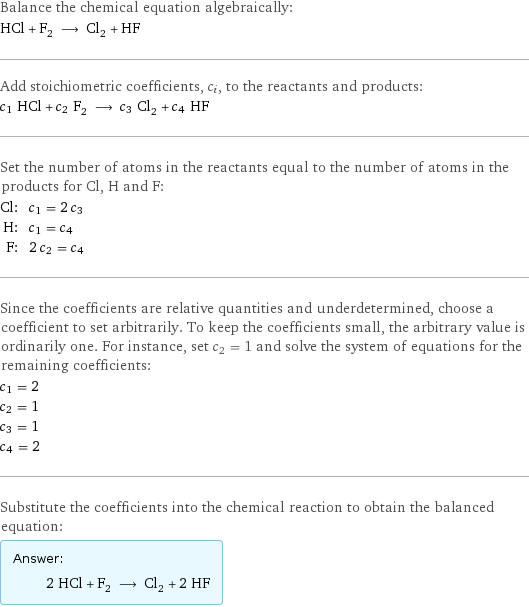
Balance the chemical equation algebraically: HCl + F_2 ⟶ Cl_2 + HF Add stoichiometric coefficients, c_i, to the reactants and products: c_1 HCl + c_2 F_2 ⟶ c_3 Cl_2 + c_4 HF Set the number of atoms in the reactants equal to the number of atoms in the products for Cl, H and F: Cl: | c_1 = 2 c_3 H: | c_1 = c_4 F: | 2 c_2 = c_4 Since the coefficients are relative quantities and underdetermined, choose a coefficient to set arbitrarily. To keep the coefficients small, the arbitrary value is ordinarily one. For instance, set c_2 = 1 and solve the system of equations for the remaining coefficients: c_1 = 2 c_2 = 1 c_3 = 1 c_4 = 2 Substitute the coefficients into the chemical reaction to obtain the balanced equation: Answer: | | 2 HCl + F_2 ⟶ Cl_2 + 2 HF
Structures

+ ⟶ +
Names

hydrogen chloride + fluorine ⟶ chlorine + hydrogen fluoride
Reaction thermodynamics
Enthalpy
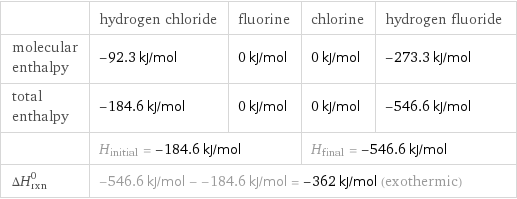
| hydrogen chloride | fluorine | chlorine | hydrogen fluoride molecular enthalpy | -92.3 kJ/mol | 0 kJ/mol | 0 kJ/mol | -273.3 kJ/mol total enthalpy | -184.6 kJ/mol | 0 kJ/mol | 0 kJ/mol | -546.6 kJ/mol | H_initial = -184.6 kJ/mol | | H_final = -546.6 kJ/mol | ΔH_rxn^0 | -546.6 kJ/mol - -184.6 kJ/mol = -362 kJ/mol (exothermic) | | |
Gibbs free energy
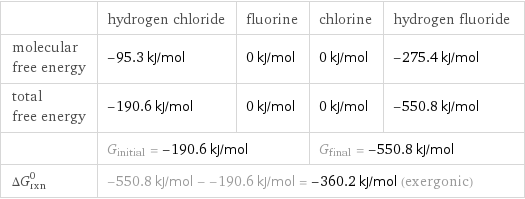
| hydrogen chloride | fluorine | chlorine | hydrogen fluoride molecular free energy | -95.3 kJ/mol | 0 kJ/mol | 0 kJ/mol | -275.4 kJ/mol total free energy | -190.6 kJ/mol | 0 kJ/mol | 0 kJ/mol | -550.8 kJ/mol | G_initial = -190.6 kJ/mol | | G_final = -550.8 kJ/mol | ΔG_rxn^0 | -550.8 kJ/mol - -190.6 kJ/mol = -360.2 kJ/mol (exergonic) | | |
Entropy

| hydrogen chloride | fluorine | chlorine | hydrogen fluoride molecular entropy | 187 J/(mol K) | 202.8 J/(mol K) | 223 J/(mol K) | 173.8 J/(mol K) total entropy | 374 J/(mol K) | 202.8 J/(mol K) | 223 J/(mol K) | 347.6 J/(mol K) | S_initial = 576.8 J/(mol K) | | S_final = 570.6 J/(mol K) | ΔS_rxn^0 | 570.6 J/(mol K) - 576.8 J/(mol K) = -6.2 J/(mol K) (exoentropic) | | |
Equilibrium constant
![Construct the equilibrium constant, K, expression for: HCl + F_2 ⟶ Cl_2 + HF Plan: • Balance the chemical equation. • Determine the stoichiometric numbers. • Assemble the activity expression for each chemical species. • Use the activity expressions to build the equilibrium constant expression. Write the balanced chemical equation: 2 HCl + F_2 ⟶ Cl_2 + 2 HF Assign stoichiometric numbers, ν_i, using the stoichiometric coefficients, c_i, from the balanced chemical equation in the following manner: ν_i = -c_i for reactants and ν_i = c_i for products: chemical species | c_i | ν_i HCl | 2 | -2 F_2 | 1 | -1 Cl_2 | 1 | 1 HF | 2 | 2 Assemble the activity expressions accounting for the state of matter and ν_i: chemical species | c_i | ν_i | activity expression HCl | 2 | -2 | ([HCl])^(-2) F_2 | 1 | -1 | ([F2])^(-1) Cl_2 | 1 | 1 | [Cl2] HF | 2 | 2 | ([HF])^2 The equilibrium constant symbol in the concentration basis is: K_c Mulitply the activity expressions to arrive at the K_c expression: Answer: | | K_c = ([HCl])^(-2) ([F2])^(-1) [Cl2] ([HF])^2 = ([Cl2] ([HF])^2)/(([HCl])^2 [F2])](../image_source/87deeb0483cac09b3dd59f47d56dc8a1.png)
Construct the equilibrium constant, K, expression for: HCl + F_2 ⟶ Cl_2 + HF Plan: • Balance the chemical equation. • Determine the stoichiometric numbers. • Assemble the activity expression for each chemical species. • Use the activity expressions to build the equilibrium constant expression. Write the balanced chemical equation: 2 HCl + F_2 ⟶ Cl_2 + 2 HF Assign stoichiometric numbers, ν_i, using the stoichiometric coefficients, c_i, from the balanced chemical equation in the following manner: ν_i = -c_i for reactants and ν_i = c_i for products: chemical species | c_i | ν_i HCl | 2 | -2 F_2 | 1 | -1 Cl_2 | 1 | 1 HF | 2 | 2 Assemble the activity expressions accounting for the state of matter and ν_i: chemical species | c_i | ν_i | activity expression HCl | 2 | -2 | ([HCl])^(-2) F_2 | 1 | -1 | ([F2])^(-1) Cl_2 | 1 | 1 | [Cl2] HF | 2 | 2 | ([HF])^2 The equilibrium constant symbol in the concentration basis is: K_c Mulitply the activity expressions to arrive at the K_c expression: Answer: | | K_c = ([HCl])^(-2) ([F2])^(-1) [Cl2] ([HF])^2 = ([Cl2] ([HF])^2)/(([HCl])^2 [F2])
Rate of reaction
![Construct the rate of reaction expression for: HCl + F_2 ⟶ Cl_2 + HF Plan: • Balance the chemical equation. • Determine the stoichiometric numbers. • Assemble the rate term for each chemical species. • Write the rate of reaction expression. Write the balanced chemical equation: 2 HCl + F_2 ⟶ Cl_2 + 2 HF Assign stoichiometric numbers, ν_i, using the stoichiometric coefficients, c_i, from the balanced chemical equation in the following manner: ν_i = -c_i for reactants and ν_i = c_i for products: chemical species | c_i | ν_i HCl | 2 | -2 F_2 | 1 | -1 Cl_2 | 1 | 1 HF | 2 | 2 The rate term for each chemical species, B_i, is 1/ν_i(Δ[B_i])/(Δt) where [B_i] is the amount concentration and t is time: chemical species | c_i | ν_i | rate term HCl | 2 | -2 | -1/2 (Δ[HCl])/(Δt) F_2 | 1 | -1 | -(Δ[F2])/(Δt) Cl_2 | 1 | 1 | (Δ[Cl2])/(Δt) HF | 2 | 2 | 1/2 (Δ[HF])/(Δt) (for infinitesimal rate of change, replace Δ with d) Set the rate terms equal to each other to arrive at the rate expression: Answer: | | rate = -1/2 (Δ[HCl])/(Δt) = -(Δ[F2])/(Δt) = (Δ[Cl2])/(Δt) = 1/2 (Δ[HF])/(Δt) (assuming constant volume and no accumulation of intermediates or side products)](../image_source/cbc17db4e22b6519d9518f46a0ce9835.png)
Construct the rate of reaction expression for: HCl + F_2 ⟶ Cl_2 + HF Plan: • Balance the chemical equation. • Determine the stoichiometric numbers. • Assemble the rate term for each chemical species. • Write the rate of reaction expression. Write the balanced chemical equation: 2 HCl + F_2 ⟶ Cl_2 + 2 HF Assign stoichiometric numbers, ν_i, using the stoichiometric coefficients, c_i, from the balanced chemical equation in the following manner: ν_i = -c_i for reactants and ν_i = c_i for products: chemical species | c_i | ν_i HCl | 2 | -2 F_2 | 1 | -1 Cl_2 | 1 | 1 HF | 2 | 2 The rate term for each chemical species, B_i, is 1/ν_i(Δ[B_i])/(Δt) where [B_i] is the amount concentration and t is time: chemical species | c_i | ν_i | rate term HCl | 2 | -2 | -1/2 (Δ[HCl])/(Δt) F_2 | 1 | -1 | -(Δ[F2])/(Δt) Cl_2 | 1 | 1 | (Δ[Cl2])/(Δt) HF | 2 | 2 | 1/2 (Δ[HF])/(Δt) (for infinitesimal rate of change, replace Δ with d) Set the rate terms equal to each other to arrive at the rate expression: Answer: | | rate = -1/2 (Δ[HCl])/(Δt) = -(Δ[F2])/(Δt) = (Δ[Cl2])/(Δt) = 1/2 (Δ[HF])/(Δt) (assuming constant volume and no accumulation of intermediates or side products)
Chemical names and formulas
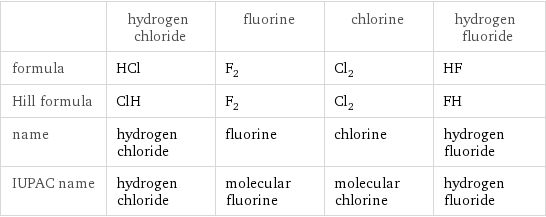
| hydrogen chloride | fluorine | chlorine | hydrogen fluoride formula | HCl | F_2 | Cl_2 | HF Hill formula | ClH | F_2 | Cl_2 | FH name | hydrogen chloride | fluorine | chlorine | hydrogen fluoride IUPAC name | hydrogen chloride | molecular fluorine | molecular chlorine | hydrogen fluoride
Substance properties
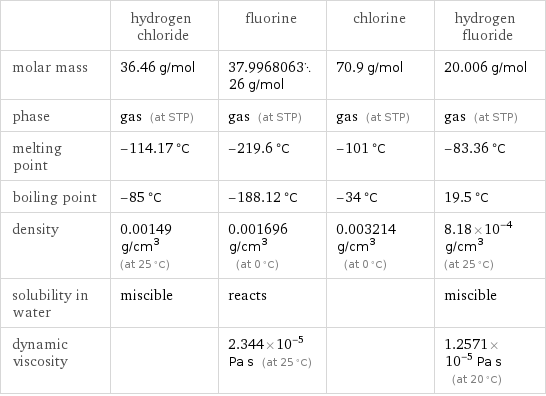
| hydrogen chloride | fluorine | chlorine | hydrogen fluoride molar mass | 36.46 g/mol | 37.996806326 g/mol | 70.9 g/mol | 20.006 g/mol phase | gas (at STP) | gas (at STP) | gas (at STP) | gas (at STP) melting point | -114.17 °C | -219.6 °C | -101 °C | -83.36 °C boiling point | -85 °C | -188.12 °C | -34 °C | 19.5 °C density | 0.00149 g/cm^3 (at 25 °C) | 0.001696 g/cm^3 (at 0 °C) | 0.003214 g/cm^3 (at 0 °C) | 8.18×10^-4 g/cm^3 (at 25 °C) solubility in water | miscible | reacts | | miscible dynamic viscosity | | 2.344×10^-5 Pa s (at 25 °C) | | 1.2571×10^-5 Pa s (at 20 °C)
Units
